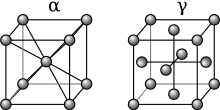Austenite
metallic, non-magnetic allotrope of iron or a solid solution of iron, with an alloying element
Austenite is iron but in a metallic form. It is one of the allotropes of iron, which means its physical form is different from iron, but its chemical form is the same.[1][2] It is named after Sir William Chandler Roberts-Austen (1843–1902).[3]


Austenitization
changeAustenitization means to heat iron, iron-based metal, or steel to a high temperature. At that temperature, the crystal structure of the metal changes from ferrite to austenite,[4][5] which can dissolve more carbon.
For some irons, iron-based metals, and steels, the presence of carbides may occur during this austenitization step. The term commonly used for this is two-phase austenitization.[6]
References
change- ↑ "Dictionary.com". Dictionary. Retrieved May 18, 2016.
- ↑ Reed-Hill R, Abbaschian R (1991). Physical Metallurgy Principles, 3rd Edition. Boston: PWS-Kent Publishing. ISBN 0-534-92173-6.
- ↑ Gove PB, ed. (1963). Webster's Seventh New Collegiate Dictionary. Springfield, Massachusetts, USA: G & C Merriam Company. p. 58.
- ↑ Nichols R (Jul 2001). "Quenching and tempering of welded carbon steel tubulars".
- ↑ Lambers HG, Tschumak S, Maier HJ, Canadinc D (Apr 2009). "Role of Austenitization and Pre-Deformation on the Kinetics of the Isothermal Bainitic Transformation". Metal Mater Trans A. 40 (6): 1355–1366. Bibcode:2009MMTA..tmp...74L. doi:10.1007/s11661-009-9827-z. S2CID 136882327.
{{cite journal}}: CS1 maint: bibcode (link) CS1 maint: multiple names: authors list (link) - ↑ "Austenitization".
Other websites
change- Fe-Fe3C phase diagram Archived 2008-02-16 at the Wayback Machine